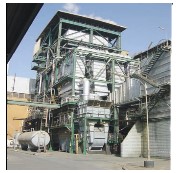
Arecord 15,795 mw of new power
generation capacity got added to
the national grid during 2010-11,
according to statistics presented by
Union power minister Sushilkumar
Shinde in Parliament recently. While 42
projects for 12,160 mw were
commissioned over the year, seven other
projects with total capacity of 3,635 mw
were synchronized, though they had yet
to achieve full-load commercial
operations. Fiscal year 2009-10 had seen
9,585 mw worth of fresh power
generation capacity.
Commissioning of new capacity
progressed rapidly from around 2,065
mw in the first quarter to 2,870 mw in
the second, only to reach a high of 4,795
mw in the third quarter. The last quarter, however, could not
keep pace and witnessed addition of only 2,430 mw, with the
year ending with 12,160 mw of new additions. Private sector
contributed 5,122 mw, Central government-owned utilities
4,280, mw and state government-owned entities 2,759 mw.
Thermal power dominated with 33 projects aggregating
11,250 mw commissioned during the fiscal; followed by
eight hydro power for 690 mw and one nuclear power
project of 220 mw.
The seven power projects synchronized during the year
were all coal-based projects. These include three state
government projects (capacity: 1,250 mw), three private
sector projects (capacity: 1725 mw) and one Central
government project (capacity: 660 mw).
In the meantime, according to statistics released by
Central Electricity Authority (CEA), February witnessed
only 250 mw fructified, reflecting Bawana CCPP, U-2 (250
mw) of PPCL commissioned on February 17. The feat met
only a fourth of the addition planned for the month and the
gross addition of 10,461 mw in the first eleven months of the
ongoing year fell 44 per cent short of target for the period.
Private sector accounted for a half of the capacity
commissioned during April-February 2010-11, while Central
and State government utilities filled in the balance half.
Cumulatively, the net capacity
addition in public utilities till February in
the ongoing 11th Plan amounted to
28,903 mw, comprising 25,310 mw of
thermal, 2,713 mw of hydro (renewable)
and 880 mw of nuclear power. The
renewable energy sources (grid
connected) including small hydro power,
biomass gas/power and wind energy, etc
whose estimates are sourced from
Ministry of Renewable Energy (MNRE)
contributed 10,694 mw. The addition to
stock of public utilities has already
exceeded 21,151 mw added during 10th
plan and 18,524 mw in the 9th Plan.
Renewable energy, a star performer, has
in fact already surpassed the climb in
earlier plan by 74 per cent.
Power transmission: The capacity addition of 29,076
ckm to 400kV transmission lines and 19,158 ckm to 220 kV
transmission lines till February in the ongoing 11th Plan
has already exceeded their respective additions during the
10th Plan. Likewise the additions in terms of MVA in 400
kV and 220 kV substations have also surpassed their 10th
plan augmentations.
Power generation: Total power generation including
that from Bhutan joint venture increased by 6.78 per cent in
February, and 5.3 per cent over the first 11 months of FY11.
Thermal power increased 3.6 per cent, hydro power 9.5 per
cent and nuclear power, 39.9 per cent. Capacity utilization
in 2010-11, as measured by plant load factor in thermal
power, dropped from 77.2 per cent to 74.3 per cent, while
that in nuclear plants improved from 50.4 per cent to 63.4
per cent due to better availability of nuclear fuels.
Power deficit: Power deficit during the first eleven
months of FY11 worked out to 8.6 per cent, improving from
9.9 per cent in the corresponding period a year ago, and 11
per cent in this period two years back. In fact, after running
higher till August, relative to year ago levels, power deficit
has tended to be less severe than year-ago levels in the
subsequent six months. Cumulative peak demand level
deficit worked out to 10.3 per cent, against 12.6 per cent in
the similar period last year and 13.8 per cent two years back.
Lower power shortage could be reflective of a slowing
economy as growth in generation during the period was
lower than that a year ago.
Maharashtra, the biggest power consuming state, faced a 17
per cent power deficit during April-January 2010-11. Madhya
Pradesh faced 20 per cent deficit and Uttar Pradesh 22 per cent.
Down south, Karnataka faced a 7.5 per cent power deficit with
comparable metrics for Andhra Pradesh and Tamil Nadu
standing at 3.2 per cent and 6.3 per cent, respectively.
Untitled Document
Power Sector Performance in XI Plan period |
Parameter |
Unit |
2007-08 |
2008-09 |
2009-10 |
2010-11 |
(Apr-Mar) |
(Apr-Feb) |
| Capacity addition |
mw |
9,263 |
3,454 |
9,585 |
10,461 |
| Power generation |
Twh |
704 |
724 |
772 |
735 |
| Peak power deficit |
per cent |
9.8 |
11.0 |
10.1 |
8.6 |